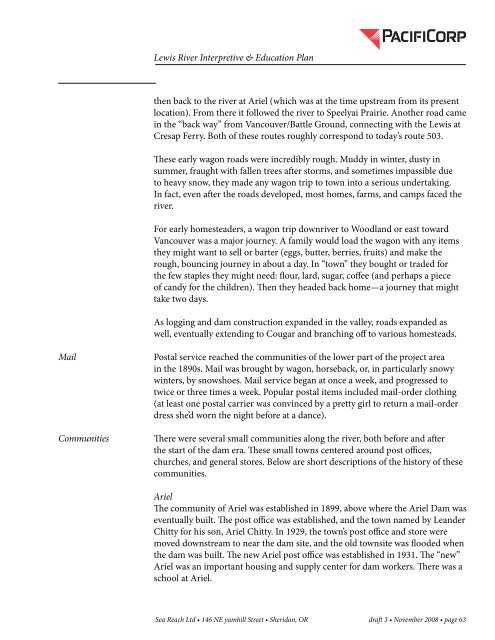The Lewis River Hydroelectric Projects - PacifiCorp
The Lewis River Hydroelectric Projects - PacifiCorp
The Lewis River Hydroelectric Projects - PacifiCorp
You also want an ePaper? Increase the reach of your titles
YUMPU automatically turns print PDFs into web optimized ePapers that Google loves.
<strong>Lewis</strong> <strong>River</strong> Interpretive & Education Plan<br />
then back to the river at Ariel (which was at the time upstream from its present<br />
location). From there it followed the river to Speelyai Prairie. Another road came<br />
in the “back way” from Vancouver/Battle Ground, connecting with the <strong>Lewis</strong> at<br />
Cresap Ferry. Both of these routes roughly correspond to today’s route 503.<br />
<strong>The</strong>se early wagon roads were incredibly rough. Muddy in winter, dusty in<br />
summer, fraught with fallen trees after storms, and sometimes impassible due<br />
to heavy snow, they made any wagon trip to town into a serious undertaking.<br />
In fact, even after the roads developed, most homes, farms, and camps faced the<br />
river.<br />
For early homesteaders, a wagon trip downriver to Woodland or east toward<br />
Vancouver was a major journey. A family would load the wagon with any items<br />
they might want to sell or barter (eggs, butter, berries, fruits) and make the<br />
rough, bouncing journey in about a day. In “town” they bought or traded for<br />
the few staples they might need: flour, lard, sugar, coffee (and perhaps a piece<br />
of candy for the children). <strong>The</strong>n they headed back home—a journey that might<br />
take two days.<br />
As logging and dam construction expanded in the valley, roads expanded as<br />
well, eventually extending to Cougar and branching off to various homesteads.<br />
Mail<br />
Communities<br />
Postal service reached the communities of the lower part of the project area<br />
in the 1890s. Mail was brought by wagon, horseback, or, in particularly snowy<br />
winters, by snowshoes. Mail service began at once a week, and progressed to<br />
twice or three times a week. Popular postal items included mail-order clothing<br />
(at least one postal carrier was convinced by a pretty girl to return a mail-order<br />
dress she’d worn the night before at a dance).<br />
<strong>The</strong>re were several small communities along the river, both before and after<br />
the start of the dam era. <strong>The</strong>se small towns centered around post offices,<br />
churches, and general stores. Below are short descriptions of the history of these<br />
communities.<br />
Ariel<br />
<strong>The</strong> community of Ariel was established in 1899, above where the Ariel Dam was<br />
eventually built. <strong>The</strong> post office was established, and the town named by Leander<br />
Chitty for his son, Ariel Chitty. In 1929, the town’s post office and store were<br />
moved downstream to near the dam site, and the old townsite was flooded when<br />
the dam was built. <strong>The</strong> new Ariel post office was established in 1931. <strong>The</strong> “new”<br />
Ariel was an important housing and supply center for dam workers. <strong>The</strong>re was a<br />
school at Ariel.<br />
Sea Reach Ltd • 146 NE yamhill Street • Sheridan, OR draft 3 • November 2008 • page 63
















